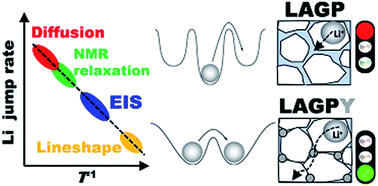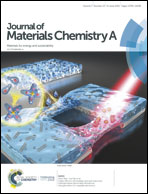NMR studies of Li mobility in NASICON-type glass-ceramic ionic conductors with optimized microstructure†
Abstract
Electrical conductivity in solid ionic conductors can be enhanced by faster ionic mobility resulting from optimizing the conducting pathways, increase of charge carrier concentration or improvement of crystallite interconnectivity. Here, we investigated the lithium ion mobility in two NASICON-type glass-ceramics of Li1.5Al0.5Ge1.5(PO4)3 (LAGP) composition, prepared with and without adding Y2O3 (5 vol%) to the glass melt before crystallization. We applied variable-temperature 7Li nuclear magnetic resonance (NMR) spectroscopy, T1 relaxation time and self-diffusion measurements as well as impedance spectroscopy to study ionic dynamics. For both materials an Arrhenius behavior of ionic mobility is obtained from various experimental approaches, thus showing a single thermally activated process in a wide temperature range with very similar activation energies of about 0.3 eV for yttrium-free and yttrium-modified LAGP ceramics. A near five-fold conductivity enhancement in the yttrium-modified sample cannot be explained by faster ionic dynamics because only minor changes of ionic mobility are registered by NMR. In conjunction with the theoretical calculations of NMR parameters and bond valence site energies, this observation suggests that the most influencing factors on ionic conductivity are an intergrain connectivity and an Li concentration enhancement, offering thus an efficient strategy for improved ionic conductors.



 Please wait while we load your content...
Please wait while we load your content...